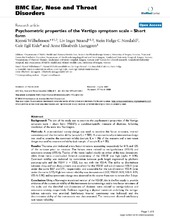| dc.contributor.author | Wilhelmsen, Kjersti Thulin | en_US |
| dc.contributor.author | Strand, Liv Inger | en_US |
| dc.contributor.author | Nordahl, Stein Helge G. | en_US |
| dc.contributor.author | Eide, Geir Egil | en_US |
| dc.contributor.author | Ljunggren, Anne Elisabeth | en_US |
| dc.date.accessioned | 2008-06-04T06:28:33Z | |
| dc.date.available | 2008-06-04T06:28:33Z | |
| dc.date.issued | 2008-03-27 | eng |
| dc.Published | BMC Ear, Nose and Throat Disorders 8(2) | en |
| dc.identifier.issn | 1472-6815 | |
| dc.identifier.uri | https://hdl.handle.net/1956/2699 | |
| dc.description.abstract | Background The aim of the study was to examine the psychometric properties of the Vertigo symptom scale – short form (VSS-SF), a condition-specific measure of dizziness, following translation of the scale into Norwegian. Methods A cross-sectional survey design was used to examine the factor structure, internal consistency and discriminative ability (sample I, n = 503). A cross-sectional pre-intervention design was used to examine the construct validity (sample II, n = 36) of the measure and a test-retest design was used to examine reliability (sub-sample of sample II, n = 28). Results The scree plot indicated a two factor structure accounting respectively for 41% and 12% of the variance prior to rotation. The factors were related to vertigo-balance (VSS-V) and autonomic-anxiety (VSS-A). Twelve of the items loaded clearly on either of the two dimensions, while three items cross-loaded. Internal consistency of the VSS-SF was high (alpha = 0.90). Construct validity was indicated by correlation between path length registered by platform posturography and the VSS-V (r = 0.52), but not with the VSS-A. The ability to discriminate between dizzy and not dizzy patients was excellent for the VSS-SF and sub-dimension VSS-V (area under the curve 0.87 and 0.91, respectively), and acceptable for the sub-dimension VSS-A (area under the curve 0.77). High test-retest reliability was demonstrated (ICC VSS-SF: 0.88, VSS-V: 0.90, VSS-A: 0.90) and no systematic change was observed in the scores from test to retest after 2 days. Conclusion Using a Norwegian translated version of the VSS-SF, this is the first study to provide evidence of the construct validity of this instrument demonstrating a stable two factor structure of the scale, and the identified sub-dimensions of dizziness were related to vertigo-balance and autonomic-anxiety, respectively. Evidence regarding a physical construct underlying the vertigo-balance sub-scale was provided. Satisfactory internal consistency was indicated, and the discriminative ability of the instruments was demonstrated. The instrument showed satisfactory test-retest reliability. | en_US |
| dc.language.iso | eng | eng |
| dc.publisher | BioMed Central | eng |
| dc.rights | Attribution CC BY | eng |
| dc.rights.uri | http://creativecommons.org/licenses/by/2.0/ | eng |
| dc.title | Psychometric properties of the Vertigo symptom scale – Short form | en_US |
| dc.type | Peer reviewed | |
| dc.type | Journal article | |
| dc.description.version | publishedVersion | en_US |
| dc.rights.holder | Copyright 2008 Wilhelmsen et al; licensee BioMed Central | |
| dc.rights.holder | Wilhelmsen et al | |
| dc.identifier.doi | https://doi.org/10.1186/1472-6815-8-2 | |
| dc.identifier.cristin | 356403 | |

